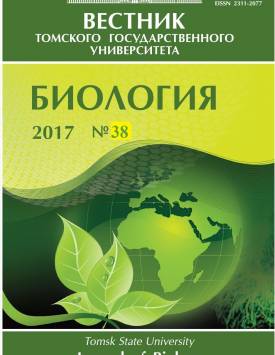Content of the major groups of biologically active substances in leaves of some Campanula species (Campanulaceae)
The present research is a continuation of publications on the phytochemical composition of Campanula species introduced in the forest-steppe zone of Western Siberia (Novosibirsk). The importance of the work is due to the recent studies confirming the biological activity of preparations from above-ground parts of bellflowers and incomplete knowledge of the majority of them. The aim of this study was a comparative characteristics of the major groups of biologically active substances (catechins, flavonols, tannins, saponins, pectic substances, ascorbic acid and carotenoids) in leaves of 8 species: C. bononiensis L., C. cervicaria L C. glomerata L., C. lactiflora Bieb. (Gadellia lactiflora (M. Bieb.) Schulkina), C. punctata Lam., C. rotundifolia L., C. takesimana Nakai, and C. thyrsoides L. We studied the collection of ornamental plants of the natural flora of the Central Siberian Botanical Garden, SB RAS in 2015-2016. The material was plants grown from seeds of different origin: Novosibirsk region (C. cervicaria), Siberian Botanical Garden, Tomsk (C. rotundifolia) and local reproductions of introduced samples (other species). To determine the quantity of metabolites, we used freshly collected raw material - leaves in the spring growth phase and leaves of flowering plants. We determined the amount of catechins spectrophotometrically (504 nm), basing on their ability to give crimson colour with vanillin solution in concentrated hydrochloric acid. A calibration curve constructed from (±)-catechin "Sigma" C-1788 (USA) was used to determine the content of catechins in a sample. The amount of flavonols was determined spectrophotometrically (415 nm) by a reaction of complexation of flavonols with aluminium chloride. A calibration schedule constructed from rutin was used to determine the concentration of flavonols. The content of tannins (hydrolysable tanning substances) was determined spectrophotometrically (420 nm) using a 2% aqueous solution of ammonium molibdate. Tanning substances were calculated according to state standard reference samples of tannins. The content of saponins was determined by weighing. The content of pectic substances (pectins and protopectins) was determined by noncarbazole spectrophotometric method (480 nm), based on obtaining a specific yellow-orange colour of uronic acids with thymol in sulfuric acid medium. To obtain reproducible results, we removed sugars from raw material. The percentage of pectic substances was determined using a calibration curve constructed from galacturonic acid. Ascorbic acid was determined by titrimetric method based on its reducing properties (Tilmans' reaction). The total amount of carotenoids was determined in acetone-ethanol extract spectrophotometrically. The optical density of the solution was measured at wavelengths corresponding to absorption maxima of chlorophylls a (662 nm) and b (644 nm) carotenoids (440.5 nm). Pigment concentration was calculated according to the formulae: Са + СЬ = 5,134D662 + 20,436D644; Carotenoids = 4,695D440,5 -0,268(Са + СЬ). All biochemical parameters, except for ascorbic acid, were calculated in relation to the mass of absolutely dry raw material. We noted a high content of flavonols (up to 9.4%), tannins (up to 34.7%), saponins (up to 39.6%), pectic substances (up to 18.3%), ascorbic acid (up to 272.8 mg%), carotenoids (up to 327.7 mg%), and small amount of catechins (up to 0.32%) in leaves (See Tables). We revealed significant interspecific and individual variability of metabolites. Their seasonal dynamics was different: the amount of tannins and saponins was higher in the phase of spring growth, but that of flavonols and pectins -in the flowering phase, while the accumulation of ascorbic acid and carotenoids was mixed. From two years of studies, more favorable conditions for the synthesis of the major metabolites formed in 2016. We determined the highest content of various groups of biologically active substances for C. rotundifolia, C. glomerata, C. punctata, C. bononiensis, and relatively low - for C. lactiflora, C. thyrsoides (See Figures and Tables). The obtained data confirmed the results of a previous study on the prospects of species of the genus Campanula as a source of flavonoids, tannins, saponins and their nutritional value due to a high content of vitamins and pectic substances in their leaves. The article contains 2 Figures, 2 Tables, 23 References.
Keywords
фенольные соединения, пектиновые вещества, аскорбиновая кислота, каротиноиды, колокольчики, Западная Сибирь, phenolic compounds, saponins, pectic substances, ascorbic acid, carotenoids, bellflowers, Western SiberiaAuthors
| Name | Organization | |
| Kukushkina Tatyana A. | Central Siberian Botanical Garden, Siberian Branch of the Russian Academy of Sciences | kukushkina-phyto@yandex.ru |
| Fomina Tatyana I. | Central Siberian Botanical Garden, Siberian Branch of the Russian Academy of Sciences | fomina-ti@yandex.ru |
References

Content of the major groups of biologically active substances in leaves of some Campanula species (Campanulaceae) | Vestnik Tomskogo gosudarstvennogo universiteta. Biologiya - Tomsk State University Journal of Biology. 2017. № 38. DOI: 10.17223/19988591/38/7
